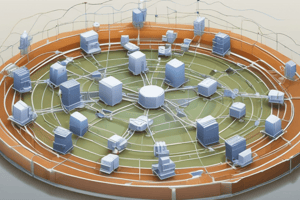Podcast
Questions and Answers
Protocols define rules for effective communication between sender and receiver.
Protocols define rules for effective communication between sender and receiver.
True (A)
What is the purpose of the application layer?
What is the purpose of the application layer?
- Control message integrity
- Transfer bits across a link
- Provide services to the user (correct)
- Route packets through the network
What does protocol layering allow us to do?
What does protocol layering allow us to do?
Divide complex tasks into smaller tasks
The protocol layering model uses a format called a ______ at the network layer.
The protocol layering model uses a format called a ______ at the network layer.
Which model provides a framework for understanding and implementing network protocols?
Which model provides a framework for understanding and implementing network protocols?
Which organization is dedicated to worldwide agreement on standards for network communications?
Which organization is dedicated to worldwide agreement on standards for network communications?
Encapsulation occurs at each layer of the TCP/IP model.
Encapsulation occurs at each layer of the TCP/IP model.
What is the main protocol used at the network layer in the TCP/IP model?
What is the main protocol used at the network layer in the TCP/IP model?
What does multiplexing refer to in the context of the TCP/IP protocol suite?
What does multiplexing refer to in the context of the TCP/IP protocol suite?
Match the following layers with their primary functions:
Match the following layers with their primary functions:
The physical layer is responsible for logical addressing.
The physical layer is responsible for logical addressing.
Flashcards are hidden until you start studying
Study Notes
Network Models Introduction
- Simple communication refers to the process of exchanging data between two entities over a network, involving the transmission of information from a source to a destination through multiple layers of protocols.
- A protocol defines the rules for effective communication between sender, receiver, and intermediate devices, specifying format, structure, and sequence of messages exchanged.
- Protocol layering is necessary for complex communication, dividing tasks between different layers, and requiring a protocol at each layer.
- The OSI model is a reference model that helps in understanding and designing network protocols, allowing for interoperability between different vendors and devices by standardizing functions and interactions at each layer.
Understand Protocol Layering
- Protocol layering enables task distribution, modularity, and separation of services from implementation.
- Each layer performs a specific task, and if there's a problem in one machine in a specific layer, only that machine needs to be changed.
- Modularity allows for machines from different manufacturers to be used interchangeably.
Logical Connections
- Logical connections between each layer enable layer-to-layer communication, helping to understand the task of layering in data communication and networking.
OSI and TCP/IP Model
- OSI (Open Systems Interconnection) and TCP/IP (Transmission Control Protocol/Internet Protocol) are two conceptual models that provide a framework for understanding and implementing network protocols and communication systems.
OSI Model
- The OSI model is a 7-layered model that helps in understanding and designing network protocols, allowing for interoperability between different vendors and devices.
- The seven layers are: Physical, Data Link, Network, Transport, Session, Presentation, and Application.
TCP/IP Protocol Suite
- TCP/IP is a hierarchical protocol suite used in the Internet, consisting of interactive modules, each providing specific functionality.
- The TCP/IP protocol suite consists of five layers: Physical, Data Link, Network, Transport, and Application.
- Each device is involved in a set of layers depending on its role in the Internet.
Layers in TCP/IP Protocol Suite
- The duty of the application, transport, and network layers is end-to-end, while the duty of the data-link and physical layers is hop-to-hop.
- The units of data are referred to as: messages or data in the application layer, segments or datagrams in the transport layer, packets in the network layer, frames in the data link layer, and bits at the physical layer.
Physical Layer
- The physical layer is responsible for carrying individual bits in a frame across the link, transforming bits into signals and transmitting them through the transmission medium.
Data Link Layer
- The data-link layer is responsible for moving the packet through the link, encapsulating the packet in a frame and forwarding it to the appropriate outgoing interface connected to the next hop or link.
Network Layer
- The network layer is responsible for host-to-host communication and routing the packet through possible routes, defining the format of the packet and the structure of addresses used in this layer.
Transport Layer
- The transport layer is responsible for delivering a message from one process to another, providing services to the application layer, and ensuring reliable process-to-process delivery of a message.
Application Layer
- The application layer is responsible for providing services to the user, required for communication between two processes (programs running at this layer).
Encapsulation and Decapsulation
- Encapsulation involves adding headers to the packet at each layer, while decapsulation involves removing headers at each layer.
- Encapsulation occurs at the source host, decapsulation and encapsulation occur at the router, and decapsulation occurs at the destination host.
Addressing
- Addressing is an important concept in protocol layering, requiring two addresses: source address and destination address.
- Addresses are used at different layers: names at the application layer, port numbers at the transport layer, global addresses at the network layer, and MAC addresses at the data link layer.
Multiplexing and Demultiplexing
- Multiplexing refers to the ability of a protocol to encapsulate packets from multiple next-higher layer protocols, one at a time.
- Demultiplexing involves decapsulating and delivering packets to multiple next-higher layer protocols, one at a time.
- Multiplexing and demultiplexing occur at different layers, requiring a field in the header to identify to which protocol the encapsulated packets belong.
Studying That Suits You
Use AI to generate personalized quizzes and flashcards to suit your learning preferences.




